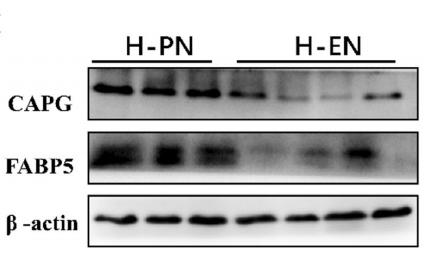CAPG Antibody - #AF0013
| Product: | CAPG Antibody |
| Catalog: | AF0013 |
| Description: | Rabbit polyclonal antibody to CAPG |
| Application: | WB IHC IF/ICC |
| Reactivity: | Human, Mouse, Rat |
| Prediction: | Pig, Bovine, Horse, Sheep, Rabbit, Dog |
| Mol.Wt.: | 39-44kDa; 38kD(Calculated). |
| Uniprot: | P40121 |
| RRID: | AB_2845466 |
Related Downloads
Protocols
Product Info
*The optimal dilutions should be determined by the end user.
*Tips:
WB: For western blot detection of denatured protein samples. IHC: For immunohistochemical detection of paraffin sections (IHC-p) or frozen sections (IHC-f) of tissue samples. IF/ICC: For immunofluorescence detection of cell samples. ELISA(peptide): For ELISA detection of antigenic peptide.
Cite Format: Affinity Biosciences Cat# AF0013, RRID:AB_2845466.
Fold/Unfold
Actin capping protein GCAP39;Actin regulatory protein CAP G;Actin regulatory protein CAP-G;AFCP;Capg;CAPG_HUMAN;Capping actin protein gelsolin like;Capping protein (actin filament) gelsolin like;Capping protein gelsolin like;Epididymis secretory protein Li 66;gCap39;Gelsolin like capping protein;HEL S 66;Macrophage capping protein;Macrophage-capping protein;mbh1;MCP;Myc basic motif homolog 1;
Immunogens
- P40121 CAPG_HUMAN:
- Protein BLAST With
- NCBI/
- ExPASy/
- Uniprot
MYTAIPQSGSPFPGSVQDPGLHVWRVEKLKPVPVAQENQGVFFSGDSYLVLHNGPEEVSHLHLWIGQQSSRDEQGACAVLAVHLNTLLGERPVQHREVQGNESDLFMSYFPRGLKYQEGGVESAFHKTSTGAPAAIKKLYQVKGKKNIRATERALNWDSFNTGDCFILDLGQNIFAWCGGKSNILERNKARDLALAIRDSERQGKAQVEIVTDGEEPAEMIQVLGPKPALKEGNPEEDLTADKANAQAAALYKVSDATGQMNLTKVADSSPFALELLISDDCFVLDNGLCGKIYIWKGRKANEKERQAALQVAEGFISRMQYAPNTQVEILPQGHESPIFKQFFKDWK
Predictions
Score>80(red) has high confidence and is suggested to be used for WB detection. *The prediction model is mainly based on the alignment of immunogen sequences, the results are for reference only, not as the basis of quality assurance.
High(score>80) Medium(80>score>50) Low(score<50) No confidence
PTMs - P40121 As Substrate
| Site | PTM Type | Enzyme | Source |
|---|---|---|---|
| M1 | Acetylation | Uniprot | |
| Y2 | Phosphorylation | Uniprot | |
| T3 | Phosphorylation | Uniprot | |
| S8 | Phosphorylation | Uniprot | |
| S10 | Phosphorylation | Uniprot | |
| S103 | Phosphorylation | Uniprot | |
| S108 | Phosphorylation | Uniprot | |
| K115 | Ubiquitination | Uniprot | |
| S123 | Phosphorylation | Uniprot | |
| K127 | Ubiquitination | Uniprot | |
| T128 | Phosphorylation | Uniprot | |
| S129 | Phosphorylation | Uniprot | |
| K137 | Acetylation | Uniprot | |
| K137 | Ubiquitination | Uniprot | |
| K143 | Ubiquitination | Uniprot | |
| T151 | Phosphorylation | Uniprot | |
| K205 | Ubiquitination | Uniprot | |
| T212 | Phosphorylation | Uniprot | |
| K227 | Ubiquitination | Uniprot | |
| K231 | Acetylation | Uniprot | |
| K231 | Ubiquitination | Uniprot | |
| K243 | Ubiquitination | Uniprot | |
| K253 | Ubiquitination | Uniprot | |
| T258 | Phosphorylation | Uniprot | |
| K297 | Ubiquitination | Uniprot | |
| S318 | Phosphorylation | Uniprot | |
| Y322 | Phosphorylation | Uniprot | |
| S337 | Phosphorylation | Uniprot |
Research Backgrounds
Calcium-sensitive protein which reversibly blocks the barbed ends of actin filaments but does not sever preformed actin filaments. May play an important role in macrophage function. May play a role in regulating cytoplasmic and/or nuclear structures through potential interactions with actin. May bind DNA.
The N-terminus is blocked.
Nucleus. Cytoplasm. Melanosome. Cell projection>Lamellipodium. Cell projection>Ruffle.
Note: In macrophages, may be predominantly cytoplasmic. Nuclear localization was observed in fibroblasts. In macrophages, present at the membrane-cytoplasm interface. In activated macrophages, concentrated in the ruffles of the leading lamellipodia.
Macrophages and macrophage-like cells.
Interacts with NUP62. Interacts with NUTF2 and RAN; involved in CAPG nuclear import.
Belongs to the villin/gelsolin family.
References
Application: WB Species: human Sample: Liver
Restrictive clause
Affinity Biosciences tests all products strictly. Citations are provided as a resource for additional applications that have not been validated by Affinity Biosciences. Please choose the appropriate format for each application and consult Materials and Methods sections for additional details about the use of any product in these publications.
For Research Use Only.
Not for use in diagnostic or therapeutic procedures. Not for resale. Not for distribution without written consent. Affinity Biosciences will not be held responsible for patent infringement or other violations that may occur with the use of our products. Affinity Biosciences, Affinity Biosciences Logo and all other trademarks are the property of Affinity Biosciences LTD.



